Electrospun Fibrous Scaffolds for Small-Diameter Blood Vessels: A Review
Abstract
:1. Introduction
2. Native Blood Vessels
3. Electrospinning Technique
4. Electrospun Fibrous Small-Diameter Blood Vessels
4.1. Synthetic Polymer-Based Electrospun Scaffolds
4.1.1. Poly(ε-caprolactone)
4.1.2. Polyurethane (PU)
4.1.3. Other Polymers
4.2. Natural Polymer-Based Electrospun Scaffolds
4.3. Electrospun Scaffolds from Polymer Blends
4.4. Electrospun Layered Fibrous Scaffolds
5. Biological Studies of Fibrous Small-Diameter Blood Vessels
5.1. In Vitro Studies
5.1.1. Endothelial Cells (ECs)
5.1.2. Fibroblast Cells (FBCs)
5.1.3. Smooth Muscle Cells (SMCs)
5.1.4. Mesenchymal Stem Cells (MSCs)
5.2. In Vivo Studies
6. Functionalization of Fibrous Small-Diameter Blood Vessel Scaffolds
6.1. Anti-Thrombogenicity
6.2. Drug Loadings
7. Conclusions
Acknowledgments
Conflicts of Interest
References
- Stegemann, J.P.; Kaszuba, S.N.; Rowe, S.L. Advances in vascular tissue engineering using protein-based biomaterials. Tissue Eng. 2007, 13, 2601–2613. [Google Scholar] [CrossRef] [PubMed]
- Gong, Z.; Niklason, L.E. Blood vessels engineered from human cells. Trends Cardiovasc. Med. 2006, 16, 153–156. [Google Scholar] [CrossRef] [PubMed]
- Collins, A.J.F. United States renal data system 2011 annual data report: Atlasofchronickidney disease & end stagerenal disease in the United States. Am. J. Kidney Dis. 2012, 59, e1–e420. [Google Scholar]
- Browning, M.; Dempsey, D.; Guiza, V.; Becerra, S.; Rivera, J.; Russell, B.; Höök, M.; Clubb, F.; Miller, M.; Fossum, T. Multilayer vascular grafts based on collagen-mimetic proteins. Acta Biomater. 2012, 8, 1010–1021. [Google Scholar] [CrossRef] [PubMed]
- Dahl, S.L.; Kypson, A.P.; Lawson, J.H.; Blum, J.L.; Strader, J.T.; Li, Y.; Manson, R.J.; Tente, W.E.; DiBernardo, L.; Hensley, M.T. Readily available tissue-engineered vascular grafts. Sci. Transl. Med. 2011, 3, 68ra9. [Google Scholar] [CrossRef] [PubMed]
- De Bakey, M.E.; Jordan, G.L.; Abbott, J.P.; Halpert, B.; O’Neal, R.M. The fate of Dacron vascular grafts. Arch. Surg. 1964, 89, 755–782. [Google Scholar] [CrossRef]
- Sayers, R.; Raptis, S.; Berce, M.; Miller, J. Long-term results of femorotibial bypass with vein or polytetrafluoroethylene. Br. J. Surg. 1998, 85, 934–938. [Google Scholar] [CrossRef] [PubMed]
- Zhang, Y.; Lim, C.T.; Ramakrishna, S.; Huang, Z.-M. Recent development of polymer nanofibers for biomedical and biotechnological applications. J. Mater. Sci. Mater. Med. 2005, 16, 933–946. [Google Scholar] [CrossRef] [PubMed]
- Huang, Z.-M.; Zhang, Y.-Z.; Kotaki, M.; Ramakrishna, S. A review on polymer nanofibers by electrospinning and their applications in nanocomposites. Compos. Sci. Technol. 2003, 63, 2223–2253. [Google Scholar] [CrossRef]
- Chen, R.; Morsi, Y.; Patel, S.; Ke, Q.-F.; Mo, X.-M. A novel approach via combination of electrospinning and FDM for tri-leaflet heart valve scaffold fabrication. Front. Mater. Sci. China 2009, 3, 359–366. [Google Scholar] [CrossRef]
- Owida, A.; Chen, R.; Patel, S.; Morsi, Y.; Mo, X. Artery vessel fabrication using the combined fused deposition modeling and electrospinning techniques. Rapid Prototyp. J. 2011, 17, 37–44. [Google Scholar] [CrossRef]
- Klinkert, P.; Post, P.; Breslau, P.; Van Bockel, J. Saphenous vein versus PTFE for above-knee femoropopliteal bypass. A review of the literature. Eur. J. Vasc. Endovasc. Surg. 2004, 27, 357–362. [Google Scholar] [CrossRef] [PubMed]
- Barnes, C.P.; Sell, S.A.; Boland, E.D.; Simpson, D.G.; Bowlin, G.L. Nanofiber technology: Designing the next generation of tissue engineering scaffolds. Adv. Drug Deliv. Rev. 2007, 59, 1413–1433. [Google Scholar] [CrossRef] [PubMed]
- Ndreu, A.; Nikkola, L.; Ylikauppila, H.; Ashammakhi, N.; Hasirci, V. Electrospun biodegradable nanofibrous mats for tissue engineering. Nanomedicine 2008, 3, 45–60. [Google Scholar] [CrossRef] [PubMed]
- Stupp, S.I.; LeBonheur, V.; Walker, K.; Li, L.-S.; Huggins, K.E.; Keser, M.; Amstutz, A. Supramolecular materials: Self-organized nanostructures. Science 1997, 276, 384–389. [Google Scholar] [CrossRef] [PubMed]
- Hasan, A.; Memic, A.; Annabi, N.; Hossain, M.; Paul, A.; Dokmeci, M.R.; Dehghani, F.; Khademhosseini, A. Electrospun scaffolds for tissue engineering of vascular grafts. Acta Biomater. 2014, 10, 11–25. [Google Scholar] [CrossRef] [PubMed]
- Donovan, D.L.; Schmidt, S.P.; Townshend, S.P.; Njus, G.O.; Sharp, W.V. Material and structural characterization of human saphenous vein. J. Vasc. Surg. 1990, 12, 531–537. [Google Scholar] [CrossRef]
- Stekelenburg, M.; Rutten, M.C.; Snoeckx, L.H.; Baaijens, F.P. Dynamic straining combined with fibrin gel cell seeding improves strength of tissue-engineered small-diameter vascular grafts. Tissue Eng. Part A 2008, 15, 1081–1089. [Google Scholar] [CrossRef] [PubMed]
- Soletti, L.; Hong, Y.; Guan, J.; Stankus, J.J.; El-Kurdi, M.S.; Wagner, W.R.; Vorp, D.A. A bilayered elastomeric scaffold for tissue engineering of small diameter vascular grafts. Acta Biomater. 2010, 6, 110–122. [Google Scholar] [CrossRef] [PubMed]
- Yamada, H.; Evans, F. Mechanical properties of circulatory organs and tissues. In Strength of Biological Materials; Robert E. Krieger Press: New York, NY, USA, 1970; pp. 106–113. [Google Scholar]
- Porter, T.R.; Taylor, D.O.; Fields, J.; Cycan, A.; Akosah, K.; Mohanty, P.K.; Pandian, N.G. Direct in vivo evaluation of pulmonary arterial pathology in chronic congestive heart failure with catheter-based intravascular ultrasound imaging. Am. J. Cardiol. 1993, 71, 754–757. [Google Scholar] [CrossRef]
- L’Heureux, N.; Dusserre, N.; Konig, G.; Victor, B.; Keire, P.; Wight, T.N.; Chronos, N.A.; Kyles, A.E.; Gregory, C.R.; Hoyt, G. Human tissue engineered blood vessel for adult arterial revascularization. Nat. Med. 2006, 12, 361–365. [Google Scholar] [CrossRef] [PubMed]
- Shadwick, R.E. Mechanical design in arteries. J. Exp. Biol. 1999, 202, 3305–3313. [Google Scholar] [PubMed]
- Agarwal, S.; Wendorff, J.H.; Greiner, A. Use of electrospinning technique for biomedical applications. Polymer 2008, 49, 5603–5621. [Google Scholar] [CrossRef]
- Bhardwaj, N.; Kundu, S.C. Electrospinning: A fascinating fiber fabrication technique. Biotechnol. Adv. 2010, 28, 325–347. [Google Scholar] [CrossRef] [PubMed]
- Sill, T.J.; von Recum, H.A. Electrospinning: Applications in drug delivery and tissue engineering. Biomaterials 2008, 29, 1989–2006. [Google Scholar] [CrossRef] [PubMed]
- Reneker, D.H.; Chun, I. Nanometre diameter fibres of polymer, produced by electrospinning. Nanotechnology 1996, 7, 216. [Google Scholar] [CrossRef]
- Meechaisue, C.; Dubin, R.; Supaphol, P.; Hoven, V.P.; Kohn, J. Electrospun mat of tyrosine-derived polycarbonate fibers for potential use as tissue scaffolding material. J. Biomater. Sci. Polym. Ed. 2006, 17, 1039–1056. [Google Scholar] [CrossRef] [PubMed]
- Boudriot, U.; Dersch, R.; Greiner, A.; Wendorff, J.H. Electrospinning approaches toward scaffold engineering—A brief overview. Artif. Organs 2006, 30, 785–792. [Google Scholar] [CrossRef] [PubMed]
- De Valence, S.; Tille, J.-C.; Mugnai, D.; Mrowczynski, W.; Gurny, R.; Möller, M.; Walpoth, B.H. Long term performance of polycaprolactone vascular grafts in a rat abdominal aorta replacement model. Biomaterials 2012, 33, 38–47. [Google Scholar] [CrossRef] [PubMed]
- Nottelet, B.; Pektok, E.; Mandracchia, D.; Tille, J.C.; Walpoth, B.; Gurny, R.; Moeller, M. Factorial design optimization and in vivo feasibility of poly(ε-caprolactone)-micro-and nanofiber-based small diameter vascular grafts. J. Biomed. Mater. Res. Part A 2009, 89, 865–875. [Google Scholar] [CrossRef] [PubMed]
- Hu, J.-J.; Chao, W.-C.; Lee, P.-Y.; Huang, C.-H. Construction and characterization of an electrospun tubular scaffold for small-diameter tissue-engineered vascular grafts: A scaffold membrane approach. J. Mech. Behav. Biomed. Mater. 2012, 13, 140–155. [Google Scholar] [CrossRef] [PubMed]
- Inoguchi, H.; Kwon, I.K.; Inoue, E.; Takamizawa, K.; Maehara, Y.; Matsuda, T. Mechanical responses of a compliant electrospun poly(l-lactide-co-ε-caprolactone) small-diameter vascular graft. Biomaterials 2006, 27, 1470–1478. [Google Scholar] [CrossRef] [PubMed]
- Vaz, C.; Van Tuijl, S.; Bouten, C.; Baaijens, F. Design of scaffolds for blood vessel tissue engineering using a multi-layering electrospinning technique. Acta Biomater. 2005, 1, 575–582. [Google Scholar] [CrossRef] [PubMed]
- Mun, C.H.; Jung, Y.; Kim, S.-H.; Lee, S.-H.; Kim, H.C.; Kwon, I.K.; Kim, S.H. Three-dimensional electrospun poly(lactide-co-ε-caprolactone) for small-diameter vascular grafts. Tissue Eng. Part A 2012, 18, 1608–1616. [Google Scholar] [CrossRef] [PubMed]
- Mun, C.H.; Jung, Y.; Kim, S.H.; Kim, H.C.; Kim, S.H. Effects of pulsatile bioreactor culture on vascular smooth muscle cells seeded on Electrospun Poly (lactide-co-ε-caprolactone) scaffold. Artif. Organs 2013, 37, E168–E178. [Google Scholar] [CrossRef] [PubMed]
- He, W.; Hu, Z.; Xu, A.; Liu, R.; Yin, H.; Wang, J.; Wang, S. The preparation and performance of a new polyurethane vascular prosthesis. Cell Biochem. Biophys. 2013, 66, 855–866. [Google Scholar] [CrossRef] [PubMed]
- Theron, J.; Knoetze, J.; Sanderson, R.; Hunter, R.; Mequanint, K.; Franz, T.; Zilla, P.; Bezuidenhout, D. Modification, crosslinking and reactive electrospinning of a thermoplastic medical polyurethane for vascular graft applications. Acta Biomater. 2010, 6, 2434–2447. [Google Scholar] [CrossRef] [PubMed]
- Baudis, S.; Ligon, S.C.; Seidler, K.; Weigel, G.; Grasl, C.; Bergmeister, H.; Schima, H.; Liska, R. Hard-block degradable thermoplastic urethane-elastomers for electrospun vascular prostheses. J. Polym. Sci. Part A Polym. Chem. 2012, 50, 1272–1280. [Google Scholar] [CrossRef]
- Uttayarat, P.; Perets, A.; Li, M.; Pimton, P.; Stachelek, S.J.; Alferiev, I.; Composto, R.J.; Levy, R.J.; Lelkes, P.I. Micropatterning of three-dimensional electrospun polyurethane vascular grafts. Acta Biomater. 2010, 6, 4229–4237. [Google Scholar] [CrossRef] [PubMed]
- Dargaville, B.L.; Vaquette, C.; Rasoul, F.; Cooper-White, J.J.; Campbell, J.H.; Whittaker, A.K. Electrospinning and crosslinking of low-molecular-weight poly (trimethylene carbonate-co-l-lactide) as an elastomeric scaffold for vascular engineering. Acta Biomater. 2013, 9, 6885–6897. [Google Scholar] [CrossRef] [PubMed]
- Mazalevska, O.; Struszczyk, M.H.; Krucinska, I. Design of vascular prostheses by melt electrospinning—Structural characterizations. J. Appl. Polym. Sci. 2013, 129, 779–792. [Google Scholar] [CrossRef]
- Soffer, L.; Wang, X.; Zhang, X.; Kluge, J.; Dorfmann, L.; Kaplan, D.L.; Leisk, G. Silk-based electrospun tubular scaffolds for tissue-engineered vascular grafts. J. Biomater. Sci. Polym. Ed. 2008, 19, 653–664. [Google Scholar] [CrossRef] [PubMed]
- Zhou, J.; Cao, C.; Ma, X. A novel three-dimensional tubular scaffold prepared from silk fibroin by electrospinning. Int. J. Biol. Macromol. 2009, 45, 504–510. [Google Scholar] [CrossRef] [PubMed]
- Marelli, B.; Alessandrino, A.; Farè, S.; Freddi, G.; Mantovani, D.; Tanzi, M.C. Compliant electrospun silk fibroin tubes for small vessel bypass grafting. Acta Biomater. 2010, 6, 4019–4026. [Google Scholar] [CrossRef] [PubMed]
- Salifu, A.; Nury, B.; Lekakou, C. Electrospinning of nanocomposite fibrillar tubular and flat scaffolds with controlled fiber orientation. Ann. Biomed. Eng. 2011, 39, 2510–2520. [Google Scholar] [CrossRef] [PubMed] [Green Version]
- Lamprou, D.; Zhdan, P.; Labeed, F.; Lekakou, C. Gelatine and gelatine/elastin nanocomposites for vascular grafts: Processing and characterization. J. Biomater. Appl. 2011, 26, 209–226. [Google Scholar] [CrossRef] [PubMed] [Green Version]
- Zulliger, M.A.; Rachev, A.; Stergiopulos, N. A constitutive formulation of arterial mechanics including vascular smooth muscle tone. Am. J. Physiol.-Heart Circ. Physiol. 2004, 287, H1335–H1343. [Google Scholar] [CrossRef] [PubMed]
- Holzapfel, G.A.; Sommer, G.; Gasser, C.T.; Regitnig, P. Determination of layer-specific mechanical properties of human coronary arteries with nonatherosclerotic intimal thickening and related constitutive modeling. Am. J. Physiol.-Heart Circ. Phys. 2005, 289, H2048–H2058. [Google Scholar] [CrossRef] [PubMed]
- McKenna, K.A.; Hinds, M.T.; Sarao, R.C.; Wu, P.-C.; Maslen, C.L.; Glanville, R.W.; Babcock, D.; Gregory, K.W. Mechanical property characterization of electrospun recombinant human tropoelastin for vascular graft biomaterials. Acta Biomater. 2012, 8, 225–233. [Google Scholar] [CrossRef] [PubMed]
- He, W.; Ma, Z.; Teo, W.E.; Dong, Y.X.; Robless, P.A.; Lim, T.C.; Ramakrishna, S. Tubular nanofiber scaffolds for tissue engineered small-diameter vascular grafts. J. Biomed. Mater. Res. Part A 2009, 90, 205–216. [Google Scholar] [CrossRef] [PubMed]
- Nguyen, T.-H.; Padalhin, A.R.; Seo, H.S.; Lee, B.-T. A hybrid electrospun PU/PCL scaffold satisfied the requirements of blood vessel prosthesis in terms of mechanical properties, pore size, and biocompatibility. J. Biomater. Sci. Polym. Ed. 2013, 24, 1692–1706. [Google Scholar] [CrossRef] [PubMed]
- Sankaran, K.K.; Krishnan, U.M.; Sethuraman, S. Axially aligned 3D nanofibrous grafts of PLA–PCL for small diameter cardiovascular applications. J. Biomater. Sci. Polym. Ed. 2014, 25, 1791–1812. [Google Scholar] [CrossRef] [PubMed]
- Marelli, B.; Achilli, M.; Alessandrino, A.; Freddi, G.; Tanzi, M.C.; Farè, S.; Mantovani, D. Collagen-reinforced electrospun silk fibroin tubular construct as small calibre vascular graft. Macromol. Biosci. 2012, 12, 1566–1574. [Google Scholar] [CrossRef] [PubMed]
- Fu, W.; Liu, Z.; Feng, B.; Hu, R.; He, X.; Wang, H.; Yin, M.; Huang, H.; Zhang, H.; Wang, W. Electrospun gelatin/PCL and collagen/PLCL scaffolds for vascular tissue engineering. Int. J. Nanomed. 2014, 9, 2335–2344. [Google Scholar] [CrossRef] [PubMed]
- Sell, S.; McClure, M.J.; Barnes, C.P.; Knapp, D.C.; Walpoth, B.H.; Simpson, D.G.; Bowlin, G.L. Electrospun polydioxanone-elastin blends: Potential for bioresorbable vascular grafts. Biomed. Mater. 2006, 1, 72–80. [Google Scholar] [CrossRef] [PubMed]
- Lee, S.J.; Yoo, J.J.; Lim, G.J.; Atala, A.; Stitzel, J. In vitro evaluation of electrospun nanofiber scaffolds for vascular graft application. J. Biomed. Mater. Res. Part A 2007, 83, 999–1008. [Google Scholar] [CrossRef] [PubMed]
- Wang, S.; Zhang, Y.; Wang, H.; Yin, G.; Dong, Z. Fabrication and properties of the electrospun polylactide/silk fibroin-gelatin composite tubular scaffold. Biomacromolecules 2009, 10, 2240–2244. [Google Scholar] [CrossRef] [PubMed]
- Wang, S.; Zhang, Y.; Yin, G.; Wang, H.; Dong, Z. Electrospun polylactide/silk fibroin–gelatin composite tubular scaffolds for small-diameter tissue engineering blood vessels. J. Appl. Polym. Sci. 2009, 113, 2675–2682. [Google Scholar] [CrossRef]
- McClure, M.J.; Sell, S.A.; Simpson, D.G.; Walpoth, B.H.; Bowlin, G.L. A three-layered electrospun matrix to mimic native arterial architecture using polycaprolactone, elastin, and collagen: A preliminary study. Acta Biomater. 2010, 6, 2422–2433. [Google Scholar] [CrossRef] [PubMed]
- Huang, C.; Chen, R.; Ke, Q.; Morsi, Y.; Zhang, K.; Mo, X. Electrospun collagen–chitosan–TPU nanofibrous scaffolds for tissue engineered tubular grafts. Colloids Surf. B Biointerfaces 2011, 82, 307–315. [Google Scholar] [CrossRef] [PubMed]
- Yin, A.; Zhang, K.; McClure, M.J.; Huang, C.; Wu, J.; Fang, J.; Mo, X.; Bowlin, G.L.; Al-Deyab, S.S.; El-Newehy, M. Electrospinning collagen/chitosan/poly(l-lactic acid-co-ε-caprolactone) to form a vascular graft: Mechanical and biological characterization. J. Biomed. Mater. Res. Part A 2013, 101, 1292–1301. [Google Scholar] [CrossRef] [PubMed]
- Pektok, E.; Nottelet, B.; Tille, J.-C.; Gurny, R.; Kalangos, A.; Moeller, M.; Walpoth, B.H. Degradation and healing characteristics of small-diameter poly(ε-caprolactone) vascular grafts in the rat systemic arterial circulation. Circulation 2008, 118, 2563–2570. [Google Scholar] [CrossRef] [PubMed]
- Wang, Z.; Cui, Y.; Wang, J.; Yang, X.; Wu, Y.; Wang, K.; Gao, X.; Li, D.; Li, Y.; Zheng, X.-L. The effect of thick fibers and large pores of electrospun poly(ε-caprolactone) vascular grafts on macrophage polarization and arterial regeneration. Biomaterials 2014, 35, 5700–5710. [Google Scholar] [CrossRef] [PubMed]
- Hong, Y.; Ye, S.-H.; Nieponice, A.; Soletti, L.; Vorp, D.A.; Wagner, W.R. A small diameter, fibrous vascular conduit generated from a poly(ester urethane) urea and phospholipid polymer blend. Biomaterials 2009, 30, 2457–2467. [Google Scholar] [CrossRef] [PubMed]
- Centola, M.; Rainer, A.; Spadaccio, C.; De Porcellinis, S.; Genovese, J.; Trombetta, M. Combining electrospinning and fused deposition modeling for the fabrication of a hybrid vascular graft. Biofabrication 2010, 2, 014102. [Google Scholar] [CrossRef] [PubMed]
- Wu, H.; Fan, J.; Chu, C.-C.; Wu, J. Electrospinning of small diameter 3-D nanofibrous tubular scaffolds with controllable nanofiber orientations for vascular grafts. J. Mater. Sci. Mater. Med. 2010, 21, 3207–3215. [Google Scholar] [CrossRef] [PubMed]
- Zhang, M.; Wang, K.; Wang, Z.; Xing, B.; Zhao, Q.; Kong, D. Small-diameter tissue engineered vascular graft made of electrospun PCL/lecithin blend. J. Mater. Sci. Mater. Med. 2012, 23, 2639–2648. [Google Scholar] [CrossRef] [PubMed]
- Georges, P.C.; Janmey, P.A. Cell type-specific response to growth on soft materials. J. Appl. Physiol. 2005, 98, 1547–1553. [Google Scholar] [CrossRef] [PubMed]
- Brown, X.Q.; Ookawa, K.; Wong, J.Y. Evaluation of polydimethylsiloxane scaffolds with physiologically-relevant elastic moduli: Interplay of substrate mechanics and surface chemistry effects on vascular smooth muscle cell response. Biomaterials 2005, 26, 3123–3129. [Google Scholar] [CrossRef] [PubMed]
- Hadjipanayi, E.; Mudera, V.; Brown, R. Close dependence of fibroblast proliferation on collagen scaffold matrix stiffness. J. Tissue Eng. Regen. Med. 2009, 3, 77–84. [Google Scholar] [CrossRef] [PubMed]
- Zhang, H.; Jia, X.; Han, F.; Zhao, J.; Zhao, Y.; Fan, Y.; Yuan, X. Dual-delivery of VEGF and PDGF by double-layered electrospun membranes for blood vessel regeneration. Biomaterials 2013, 34, 2202–2212. [Google Scholar] [CrossRef] [PubMed]
- Inoguchi, H.; Tanaka, T.; Maehara, Y.; Matsuda, T. The effect of gradually graded shear stress on the morphological integrity of a huvec-seeded compliant small-diameter vascular graft. Biomaterials 2007, 28, 486–495. [Google Scholar] [CrossRef] [PubMed]
- Ju, Y.M.; San Choi, J.; Atala, A.; Yoo, J.J.; Lee, S.J. Bilayered scaffold for engineering cellularized blood vessels. Biomaterials 2010, 31, 4313–4321. [Google Scholar] [CrossRef] [PubMed]
- Lee, S.J.; Liu, J.; Oh, S.H.; Soker, S.; Atala, A.; Yoo, J.J. Development of a composite vascular scaffolding system that withstands physiological vascular conditions. Biomaterials 2008, 29, 2891–2898. [Google Scholar] [CrossRef] [PubMed]
- Tillman, B.W.; Yazdani, S.K.; Lee, S.J.; Geary, R.L.; Atala, A.; Yoo, J.J. The in vivo stability of electrospun polycaprolactone-collagen scaffolds in vascular reconstruction. Biomaterials 2009, 30, 583–588. [Google Scholar] [CrossRef] [PubMed]
- Xiang, P.; Li, M.; Zhang, C.-Y.; Chen, D.-L.; Zhou, Z.-H. Cytocompatibility of electrospun nanofiber tubular scaffolds for small diameter tissue engineering blood vessels. Int. J. Biol. Macromol. 2011, 49, 281–288. [Google Scholar] [CrossRef] [PubMed]
- Zhao, J.; Qiu, H.; Chen, D.-L.; Zhang, W.-X.; Zhang, D.-C.; Li, M. Development of nanofibrous scaffolds for vascular tissue engineering. Int. J. Biol. Macromol. 2013, 56, 106–113. [Google Scholar] [CrossRef] [PubMed]
- Zhou, P.; Zhou, F.; Liu, B.; Zhao, Y.; Yuan, X. Functional electrospun fibrous scaffolds with dextran-g-poly(l-lysine)-VAPG/microRNA-145 to specially modulate vascular SMCs. J. Mater. Chem. B 2017, 5, 9312–9325. [Google Scholar] [CrossRef]
- Rayatpisheh, S.; Heath, D.E.; Shakouri, A.; Rujitanaroj, P.-O.; Chew, S.Y.; Chan-Park, M.B. Combining cell sheet technology and electrospun scaffolding for engineered tubular, aligned, and contractile blood vessels. Biomaterials 2014, 35, 2713–2719. [Google Scholar] [CrossRef] [PubMed]
- Wang, Y.; Shi, H.; Qiao, J.; Tian, Y.; Wu, M.; Zhang, W.; Lin, Y.; Niu, Z.; Huang, Y. Electrospun tubular scaffold with circumferentially aligned nanofibers for regulating smooth muscle cell growth. ACS Appl. Mater. Interfaces 2014, 6, 2958–2962. [Google Scholar] [CrossRef] [PubMed]
- Yu, E.; Zhang, J.; Thomson, J.A.; Turng, L.S. Fabrication and Characterization of electrospun thermoplastic polyurethane/fibroin small-diameter vascular grafts for vascular tissue engineering. Int. Polym. Process. J. Polym. Process. Soc. 2016, 31, 638–646. [Google Scholar] [CrossRef] [PubMed]
- Srinath, D.; Lin, S.; Knight, D.K.; Rizkalla, A.S.; Mequanint, K. Fibrous biodegradable l-alanine-based scaffolds for vascular tissue engineering. J. Tissue Eng. Regen. Med. 2014, 8, 578–588. [Google Scholar] [CrossRef] [PubMed]
- Zhang, J.; Qi, H.; Wang, H.; Hu, P.; Ou, L.; Guo, S.; Li, J.; Che, Y.; Yu, Y.; Kong, D. Engineering of vascular grafts with genetically modified bone marrow mesenchymal stem cells on poly (propylene carbonate) graft. Artif. Organs 2006, 30, 898–905. [Google Scholar] [CrossRef] [PubMed]
- Hashi, C.K.; Derugin, N.; Janairo, R.R.R.; Lee, R.; Schultz, D.; Lotz, J.; Li, S. Antithrombogenic modification of small-diameter microfibrous vascular grafts. Arterioscler. Thromb. Vasc. Biol. 2010, 30, 1621–1627. [Google Scholar] [CrossRef] [PubMed]
- Soletti, L.; Nieponice, A.; Hong, Y.; Ye, S.H.; Stankus, J.J.; Wagner, W.R.; Vorp, D.A. In vivo performance of a phospholipid-coated bioerodable elastomeric graft for small-diameter vascular applications. J. Biomed. Mater. Res. Part A 2011, 96, 436–448. [Google Scholar] [CrossRef] [PubMed]
- Bergmeister, H.; Grasl, C.; Walter, I.; Plasenzotti, R.; Stoiber, M.; Schreiber, C.; Losert, U.; Weigel, G.; Schima, H. Electrospun small-diameter polyurethane vascular grafts: Ingrowth and differentiation of vascular-specific host cells. Artif. Organs 2012, 36, 54–61. [Google Scholar] [CrossRef] [PubMed]
- Ju, Y.M.; Ahn, H.; Arenas-Herrera, J.; Kim, C.; Abolbashari, M.; Atala, A.; Yoo, J.J.; Lee, S.J. Electrospun vascular scaffold for cellularized small diameter blood vessels: A preclinical large animal study. Acta Biomater. 2017, 59, 58–67. [Google Scholar] [CrossRef] [PubMed]
- Zheng, W.; Wang, Z.; Song, L.; Zhao, Q.; Zhang, J.; Li, D.; Wang, S.; Han, J.; Zheng, X.-L.; Yang, Z. Endothelialization and patency of RGD-functionalized vascular grafts in a rabbit carotid artery model. Biomaterials 2012, 33, 2880–2891. [Google Scholar] [CrossRef] [PubMed]
- Mugnai, D.; Tille, J.-C.; Mrówczyński, W.; de Valence, S.; Montet, X.; Möller, M.; Walpoth, B.H. Experimental noninferiority trial of synthetic small-caliber biodegradable versus stable vascular grafts. J. Thorac. Cardiovasc. Surg. 2013, 146, 400–407. [Google Scholar] [CrossRef] [PubMed]
- Bergmeister, H.; Schreiber, C.; Grasl, C.; Walter, I.; Plasenzotti, R.; Stoiber, M.; Bernhard, D.; Schima, H. Healing characteristics of electrospun polyurethane grafts with various porosities. Acta Biomater. 2013, 9, 6032–6040. [Google Scholar] [CrossRef] [PubMed]
- Kuwabara, F.; Narita, Y.; Yamawaki-Ogata, A.; Kanie, K.; Kato, R.; Satake, M.; Kaneko, H.; Oshima, H.; Usui, A.; Ueda, Y. Novel small-caliber vascular grafts with trimeric peptide for acceleration of endothelialization. Ann. Thorac. Surg. 2012, 93, 156–163. [Google Scholar] [CrossRef] [PubMed]
- Wang, H.Y.; Feng, Y.K.; Zhao, H.Y.; Xiao, R.F.; Guo, J.T. Biomimetic Hemocompatible Nanofibrous Scaffolds as Potential Small-Diameter Blood Vessels by Bilayering Electrospun Technique; Advanced Materials Research; Trans Tech Publication: Zürich, Switzerland, 2011; pp. 1627–1630. [Google Scholar]
- Ye, L.; Wu, X.; Duan, H.Y.; Geng, X.; Chen, B.; Gu, Y.Q.; Zhang, A.Y.; Zhang, J.; Feng, Z.G. The in vitro and in vivo biocompatibility evaluation of heparin–poly(ε-caprolactone) conjugate for vascular tissue engineering scaffolds. J. Biomed. Mater. Res. Part A 2012, 100, 3251–3258. [Google Scholar] [CrossRef] [PubMed]
- Janairo, R.R.R.; Henry, J.J.; Lee, B.L.-P.; Hashi, C.K.; Derugin, N.; Lee, R.; Li, S. Heparin-modified small-diameter nanofibrous vascular grafts. IEEE Trans. Nanobiosci. 2012, 11, 22–27. [Google Scholar] [CrossRef] [PubMed]
- Huang, C.; Wang, S.; Qiu, L.; Ke, Q.; Zhai, W.; Mo, X. Heparin loading and pre-endothelialization in enhancing the patency rate of electrospun small-diameter vascular grafts in a canine model. ACS Appl. Mater. Interfaces 2013, 5, 2220–2226. [Google Scholar] [CrossRef] [PubMed]
- Lu, G.; Cui, S.; Geng, X.; Ye, L.; Chen, B.; Feng, Z.; Zhang, J.; Li, Z. Design and preparation of polyurethane-collagen/heparin-conjugated polycaprolactone double-layer bionic small-diameter vascular graft and its preliminary animal tests. Chin. Med. J. (Engl.) 2013, 126, 1310–1316. [Google Scholar] [PubMed]
- Yao, Y.; Wang, J.; Cui, Y.; Xu, R.; Wang, Z.; Zhang, J.; Wang, K.; Li, Y.; Zhao, Q.; Kong, D. Effect of sustained heparin release from PCL/chitosan hybrid small-diameter vascular grafts on anti-thrombogenic property and endothelialization. Acta Biomater. 2014, 10, 2739–2749. [Google Scholar] [CrossRef] [PubMed]
- Punnakitikashem, P.; Truong, D.; Menon, J.U.; Nguyen, K.T.; Hong, Y. Electrospun biodegradable elastic polyurethane scaffolds with dipyridamole release for small diameter vascular grafts. Acta Biomater. 2014, 10, 4618–4628. [Google Scholar] [CrossRef] [PubMed]

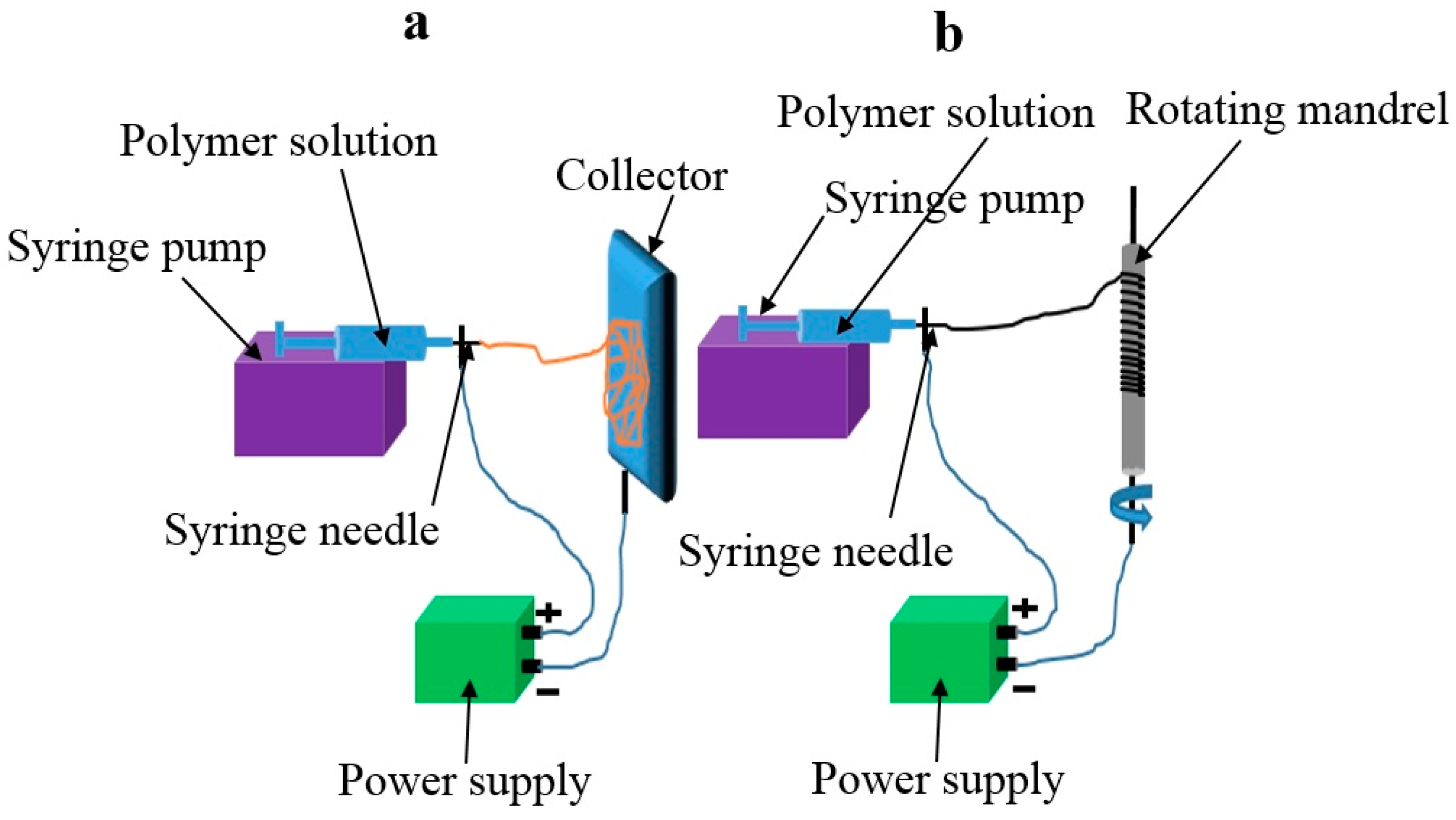
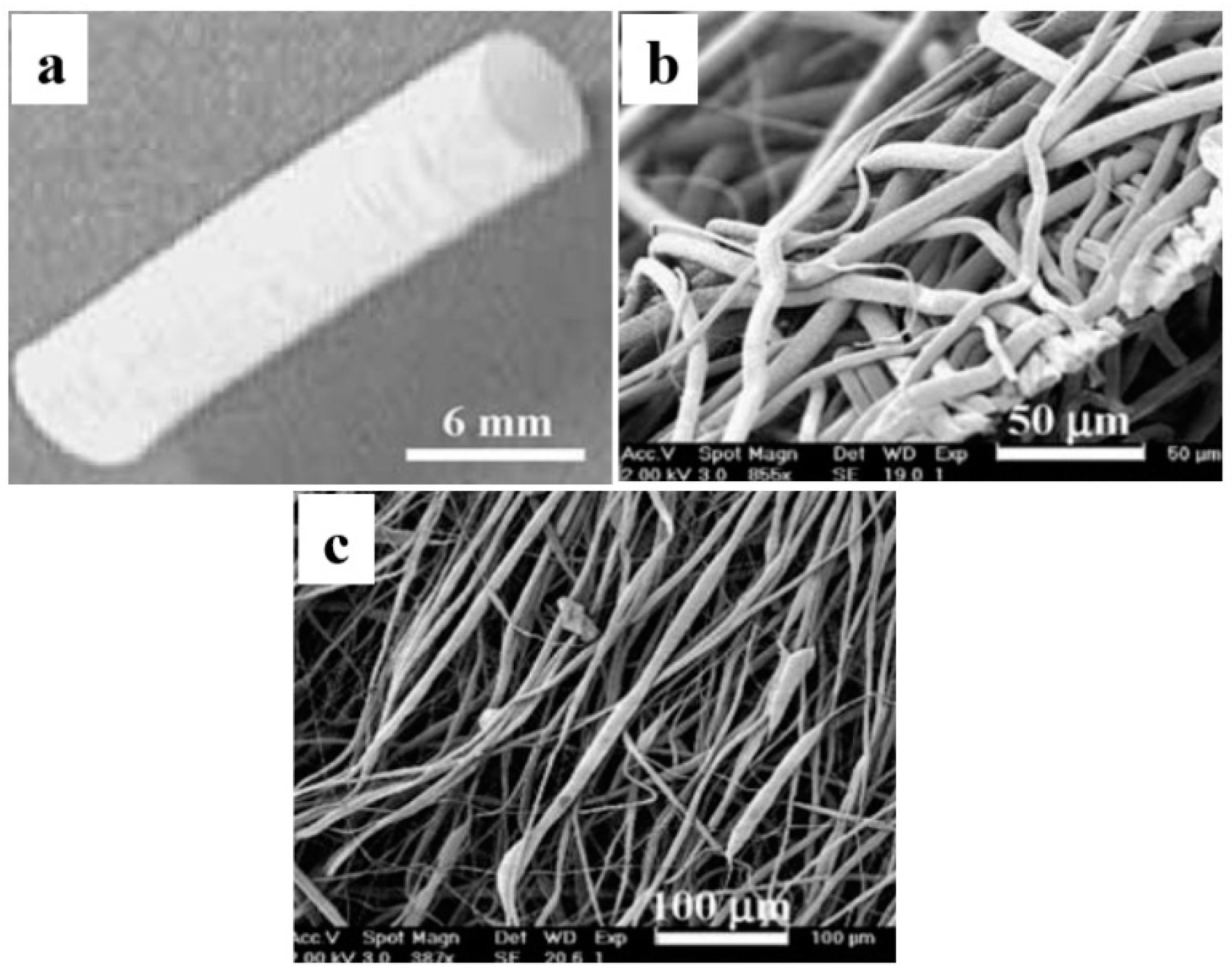
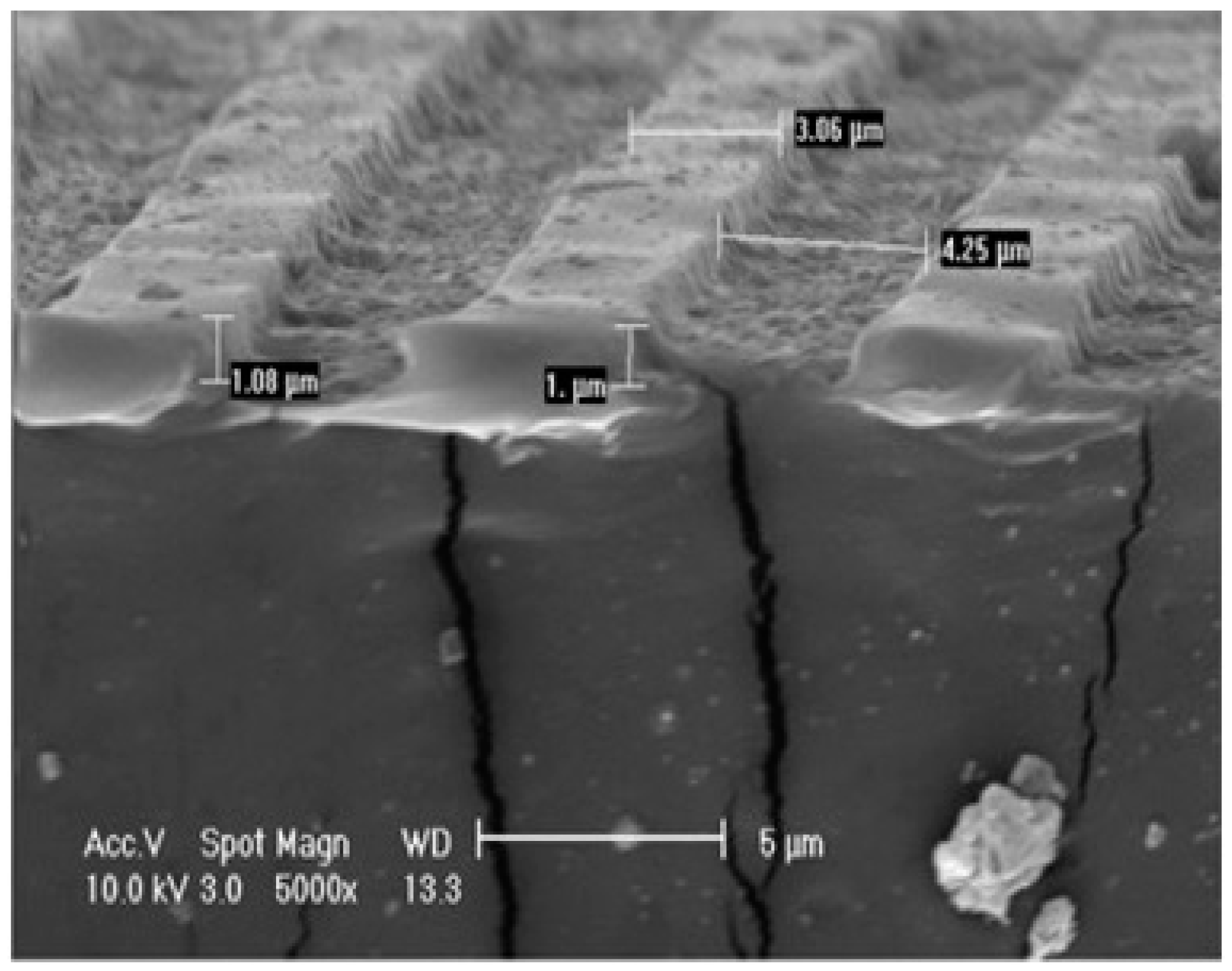

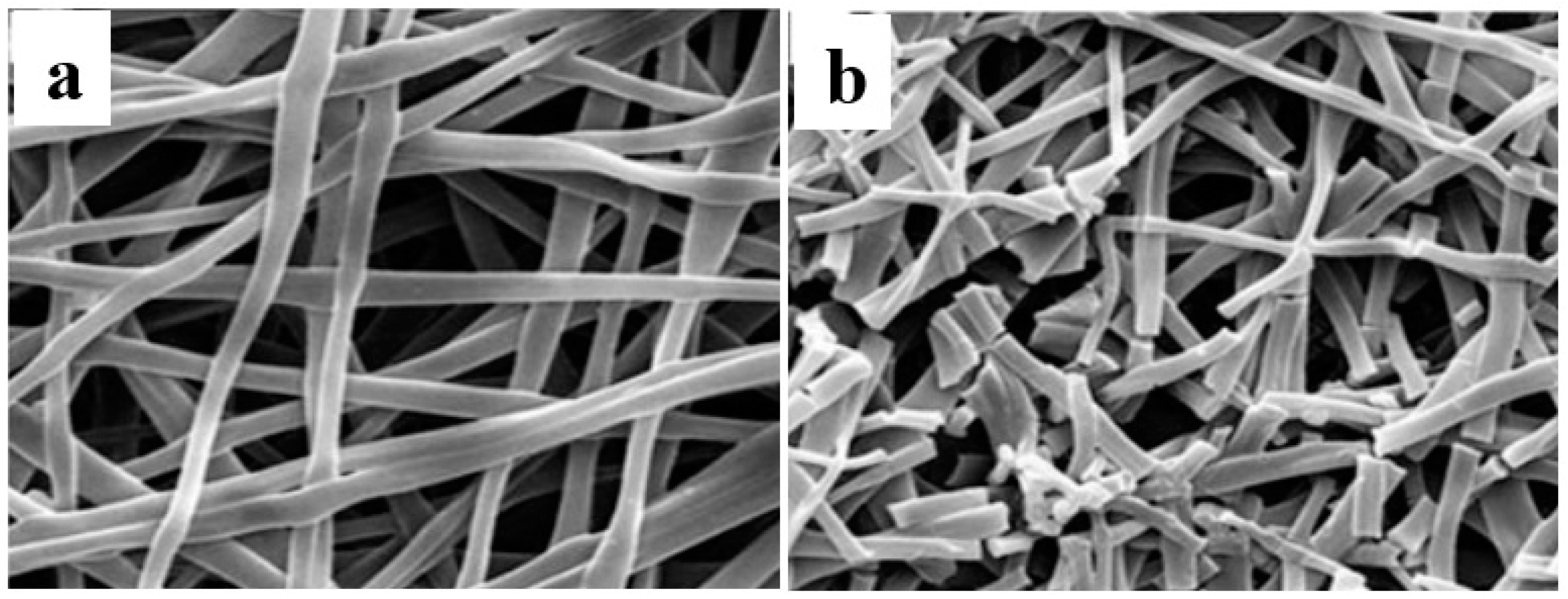
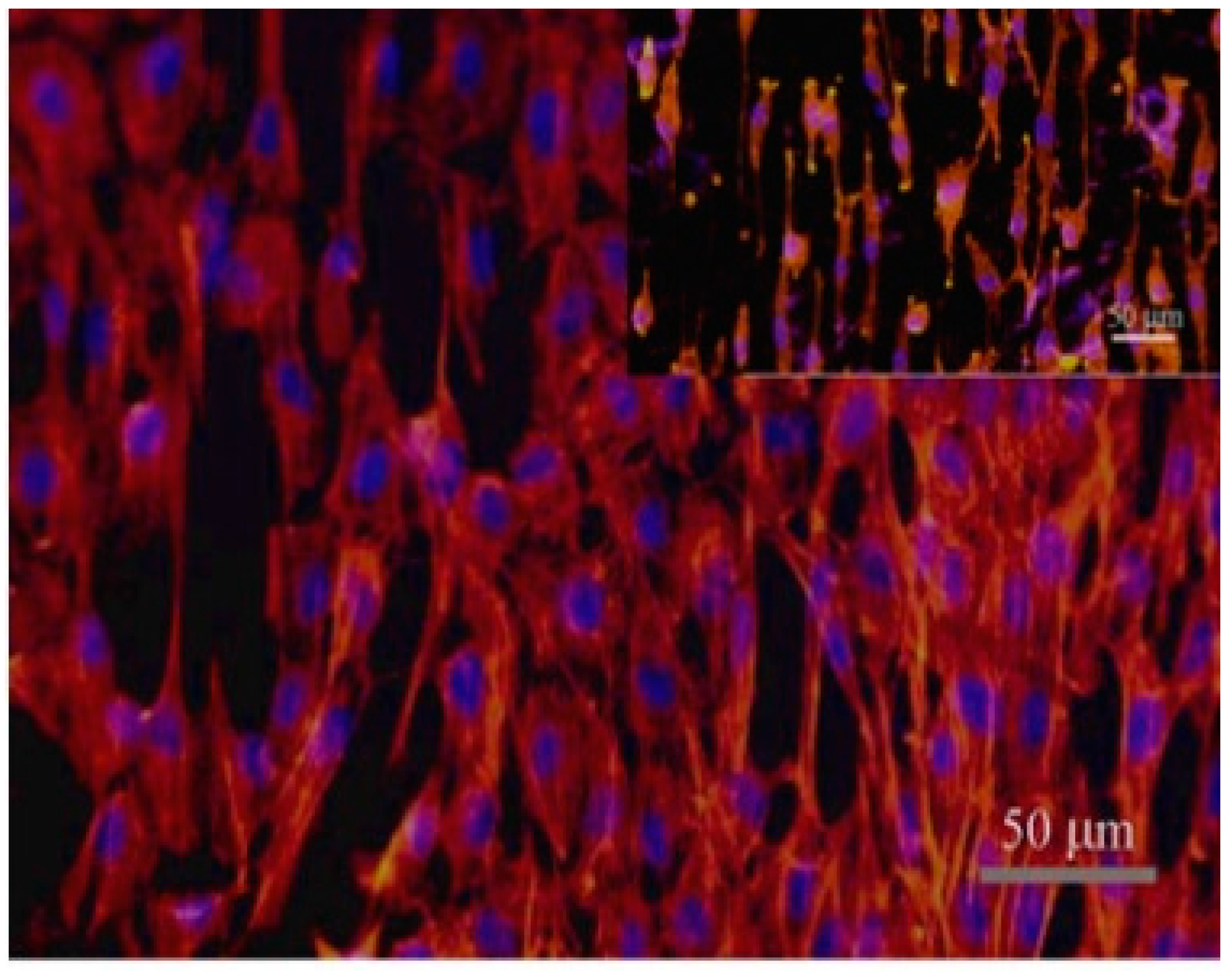
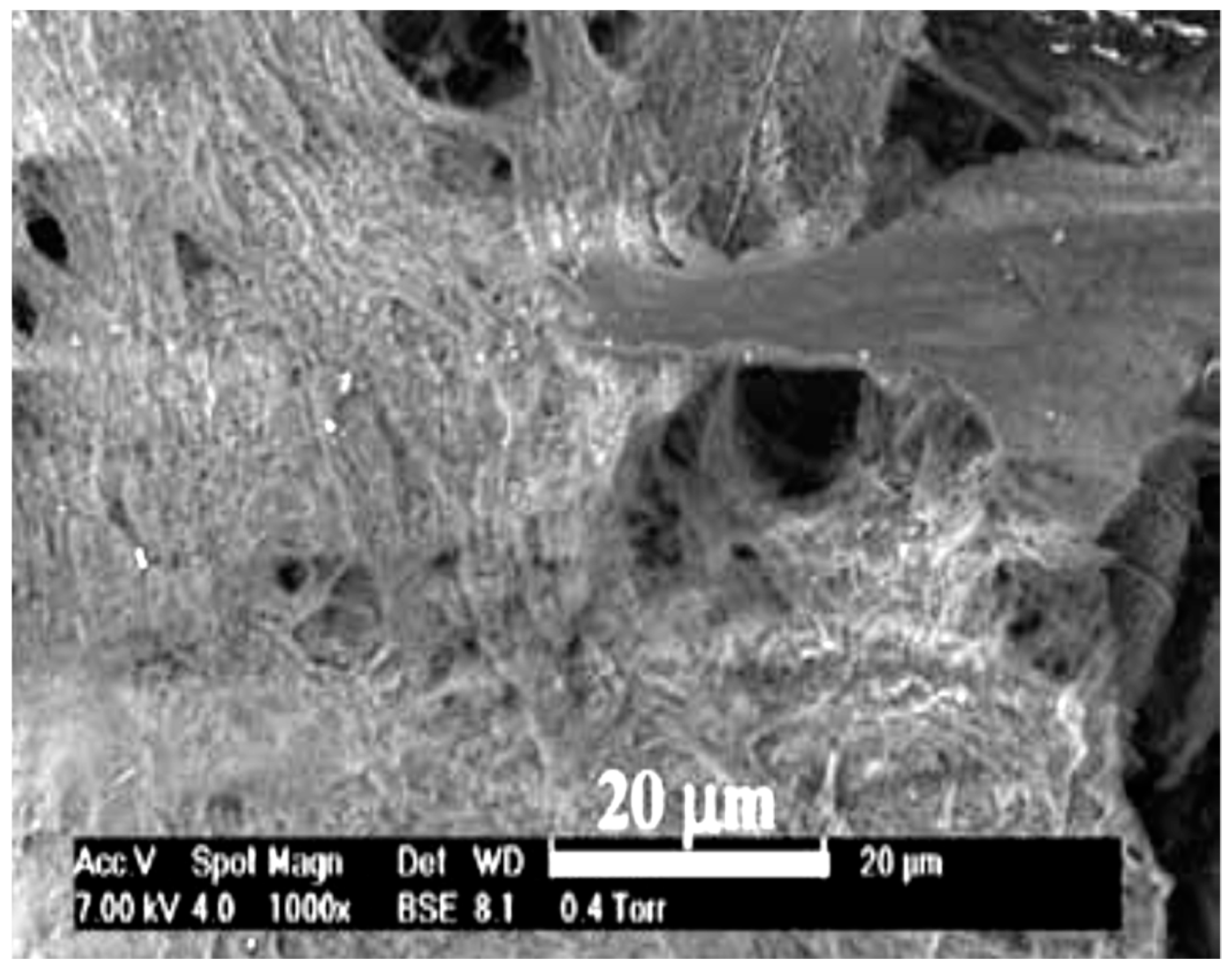
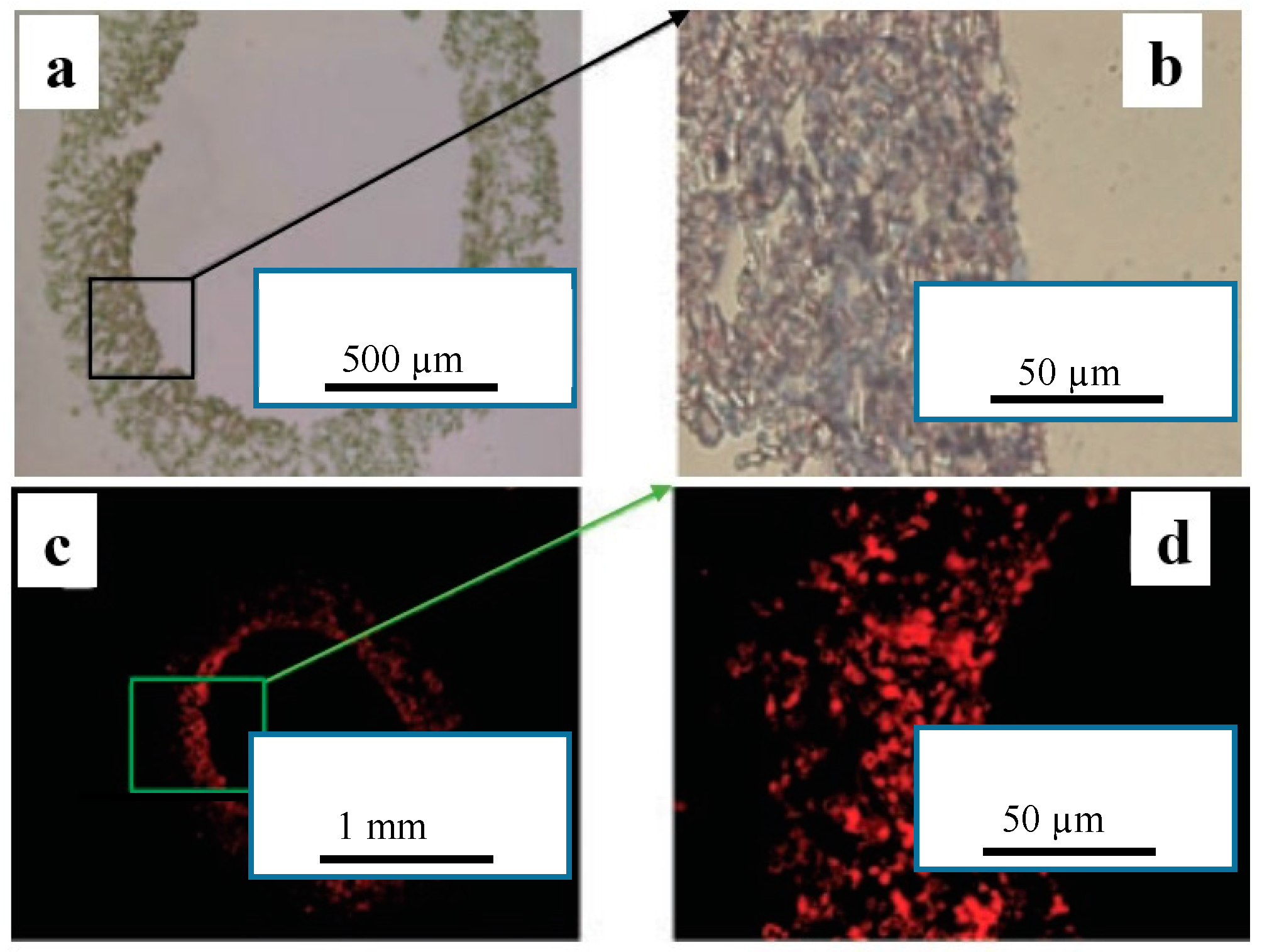
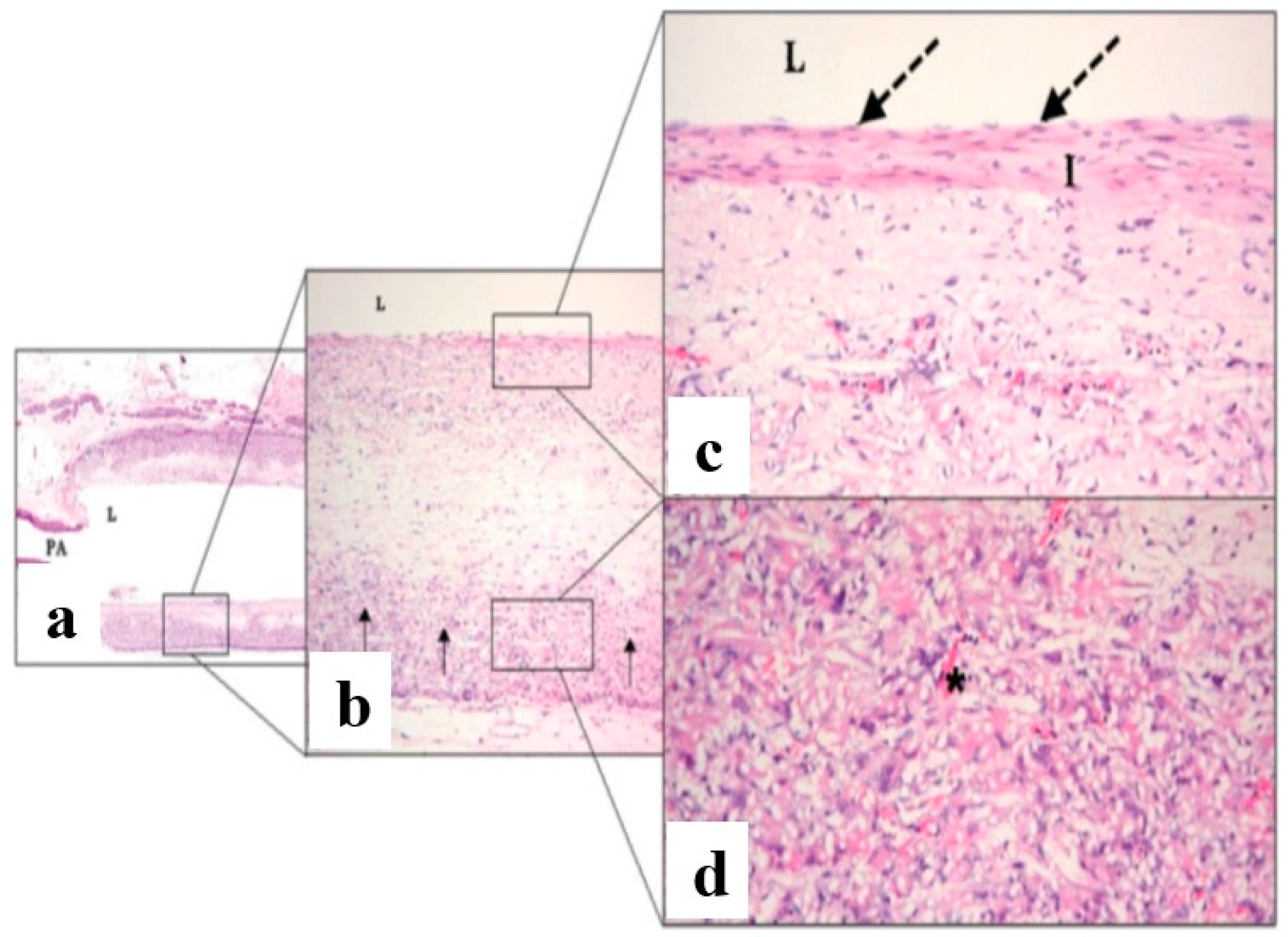

| Types | Elastic Modulus (MPa) | Ultimate Stress (MPa) | Strain at Failure (%) | Burst Strength (mmHg) | Ref. |
|---|---|---|---|---|---|
| Saphenous vein (Circ.) | 43 | 3 | 11 | NA | [17] |
| Saphenous vein (Long.) | 130 | 13 | 17 | NA | [17] |
| Saphenous vein (Circ.) | 4.2 | 1.8 | 242 | 1680–3900 | [18] |
| Saphenous vein (Long.) | 23.7 | 6.3 | 83 | NA | [18] |
| Saphenous vein (Circ.) | 2.25 | 4 | 180 | 1250 | [19] |
| Left internal mammary artery (Circ.) | 8 | 4.1 | 134 | 2000 | [18] |
| Left internal mammary artery (Long.) | 16.8 | 4.3 | 59 | NA | [18] |
| Femoral artery (Circ.) | 9–12 | 1–2 | 63–76 | NA | [20,21] |
| Polymers | Solvents | Operating Conditions | Mechanical Properties | Ref. | ||||||||
|---|---|---|---|---|---|---|---|---|---|---|---|---|
| Polymer Concentration (w/v %) | Voltage (kV) | Air Gap (cm) | Flow Rate (mL/h) | Spinning Time (min) | Mandrel Rotation Speed (rpm) | Young’s Modulus (MPa) | Maximum Stress (MPa) | Maximum Strain (%) | Burst Strength (mmHg) | |||
| Synthetic polymer-based scaffolds | ||||||||||||
| PCL-PLA | CHCl3 | 12.5 | 13 | 20 | 0.6 | 180 | 3600 | 30.9 ± 6.6 | 4.3 ± 0.2 | 47.0 ± 6.3 | [34] | |
| CHCl3/DMF | 14 | 13 | 20 | 1.5 | 180 | 10800 | 10.7 ± 0.3 | 1.2 ± 0.1 | 260 | |||
| PCL | CHCl3/EtOH | 15 | 20 | 12 | 6 | 4.8 | 600 | [43] | ||||
| PCL | CHCl3/EtOH | 5–15 | 15–25 | 12–24 | 4500 | 2–7.4 | 200–1200 | [31] | ||||
| TIPS-PEUU | HFIP | 8 | 10 | 1 | 250 | 1.4 ± 0.4 | 8.3 ± 1.7 | [19] | ||||
| PCL | CHCl3/EtOH | 15 | 20 | 12 | 6 | 4.1 ± 0.5 | 1092 ± 28 | 3280 ± 280 | [30] | |||
| PLCL | HFP | 9 | 15 | 1 | 500 | 1.2 ± 0.3 | 3.23 ± 0.57 | 270 | 933 ± 22 | [35] | ||
| PCL | CHCl/MeOH | 5 | 18 | 2 | 17.44 ± 0.91 | 13.35 ± 1.47 | 168.4 ± 8.76 | [44] | ||||
| 5 | 11 | 8 | 21.00 ± 1.39 | 8.72 ± 0.84 | 639.2 ± 24.15 | |||||||
| Natural polymer-based scaffolds | ||||||||||||
| Silk | 10–11 | 0.9 | 3000 | 2.45 ± 0.47 | 2.42 ± 0.48 | 811 | [45] | |||||
| Gelatine | TFE | 10 | 30 | 1.5 | 50 | 2 | 33.8 | 2.9 | 11.7 | [49] | ||
| (rTE) | HFP | 15 | 18.5 | 12.5 | 2 | 4400 | 0.91 ± 0.16 | 0.36 ± 0.05 | 485 ± 25 | [53] | ||
| Hybrid polymer-based scaffolds | ||||||||||||
| PDO-elastin (50:50) | HFP | 100 g/mL and 200 mg/mL | 22 | 12 | 4 and 8 | 500 | 9.64 ± 0.66 | 3.25 ± 0.24 | 64.93 ± 3.97 | [59] | ||
| Collagen-elastin-PLGA | HFP | −20 | 22 | 10 | 3 | 500 | 0.85 | 0.37 | [60] | |||
| PLLACL coated with collagen | DCM/DMF | 0 | 10 | 1 | 5 | 150 | 16.6 ± 4.4 | 3.9 ± 0.3 | 292 ± 87 | [54] | ||
| PEUU-PMBU | HFP | 15 | 10 | 15 | 1 | 5 | 250 | 3 ± 1 | 342 ± 43 | [63] | ||
| PLA-Silk Fibroin-Gelatin | formic solution | 13 | 30 | 13 | 0.2 | 1000 | 2.21 ± 0.18 | 60.58 ± 1.23 | 1596 ± 20 | [64] | ||
| CHCl3/EtOH | 5 | 25 | 15 | 0.1 | 2000 | |||||||
| PCL-collagen | HFP | 1 | 20 | 10 | 3 | 1000 | 2.7 ± 1.2 | 4.0 ± 0.4 | 140 ± 13 | 4915 ± 155 | [65] | |
| PHBV-PCL | CHCl3 | 1 | 20 | 15 | 0.5 | 3000 | 22 ± 7 | 1.4 ± 0.3 | 30 ± 20 | [66] | ||
| Collagen-hitosan-P(LLA-CL) | HFP/TFA | 14 | 12–15 | 1 | 10.3 ± 1.1 | 16.9 ± 2.9 | 112 ± 11 | >3365 ± 6 | [67] | |||
| Lecithin-cholesterol-(Chol-PCL) | CHCl3/DMF | 18 | 15 | 3 | 35.92 ± 4.75 | 5.22 ± 0.50 | 107.15 ± 10.78 | [68] | ||||
| Polymers | Cell Response | Ref. | |
|---|---|---|---|
| In Vitro Study | In Vivo Study | ||
| Synthetic Polymer-based Scaffolds | |||
| PCL-PLA | 3T3 mouse fibroblasts cells covered the surface of PCL/PAL fibrous scaffold after 4 weeks. Human venous myofibroblasts (HVS) cells were concentrated in the outer layer of PCL-PLA scaffold. | [34] | |
| PCL | Implanted in a rat revealing that endothelilization and extra cellular matrix (ECM) formation of PCL was faster than PTFE commercial grafts. | [49] | |
| PCL | In vivo implantation in rat for 12 weeks showed that the blood vessels were completely endothelilized with thrombosis formation. | [31] | |
| TIPS-PEUU | Cell culture resulted in density up to 92 ± 1% using Adult stem cells. | [19] | |
| PCL | Good patency rate, no thrombosis formation and rapid endothelilization up to 6 months of implantation in abdominal rat aorta. However, calcium deposition appeared after that at longer term of implantation. | [30] | |
| PLCL | Smooth muscle cells (SMCs) were cultured for up to 7 weeks. The viability of cells increased by increasing cell culture time (11 × 105 cells after 7 weeks). | [35] | |
| PCL | Thicker fiber diameter based PCL graft enhanced the formation of immunomodulatory and tissue remodeling (M2) phenotype when MSCs cells were cultured. | [50] | |
| Natural Polymer-based Scaffolds | |||
| Silk | Human aortic endothelial cells and coronary artery smooth muscle cells experienced good proliferation. | [51] | |
| (rTE) | Tropoelastin based blood vessel showed good endothelial cell response in terms of adhesion and proliferation. | [49] | |
| Hybrid Polymer-based Scaffolds | |||
| PDO-Elastin (50:50) | Human dermal fibroblasts cells cultured on pure PDO and PDO-elastin blend for 7 days. Hybrid scaffold of PDO-elastin showed better cell response than pure PDO in terms of adhesion, proliferation and migration. | [59] | |
| Collagen-elastin-PLGA | Ovine SMCs cultured on collagen/elastin/PLGA blend for 7 days demonstrating good cell viability (90%). | [60] | |
| PLLACL coated with collagen | P LLA-CL-collagen vascular graft demonstrated good cell response when HCAECs are cultured. | P(LLA-CL)/collagen vascular graft demonstrated good patency without thrombosis formation when implanted in rabbit veins. | [54] |
| PEUU-PMBU | Rat smooth muscle cells were cultured on PEUU/PMBU fibrous scaffold for 1 day resulting in diminishment of cell number (70–76%) compared to the control (TCPS) and pure PEUU. | Implanting the PEUU/ PMBU fibrous scaffold in rat abdominal aorta showed higher patency than PEUU. | [63] |
| PLA-silk Fibroin-Gelatin | 3T3 mouse fibroblast cells cultured for 21 days on PLA/SF-gelatin showed good proliferation. | Subcutaneous implantation test in Sprague-dawley rat for 3 months resulted in biocompatibility of the graft. | [64] |
| PCl-Collagen | Bovine endothelial cells (bECs) and smooth muscle cells (SMCs) were cultured on PCL-collagen fibrous scaffold demonstrating confluent layer of ECs on the lumen of the graft. | [65] | |
| PHBV-PCL | RCEC cells experienced apoptosis on PHBV because of its stiffness. | [66] | |
| Collagen-Chitosan-P(LLA-CL) | ECs cells demonstrated good adhesion and proliferation on collagen-chitosan-P(LLA-CL) compared to pure P(LLA-CL). | [67] | |
| Lecithin-cholesterol-PCL | MSC cells were cultured for 7 days on both pure Chol-PCL and lecithin-Chol-PCL for 7 days. MSCs proliferated better on lecithin doped Chol-PCL. | [68] | |
© 2018 by the authors. Licensee MDPI, Basel, Switzerland. This article is an open access article distributed under the terms and conditions of the Creative Commons Attribution (CC BY) license (http://creativecommons.org/licenses/by/4.0/).
Share and Cite
Awad, N.K.; Niu, H.; Ali, U.; Morsi, Y.S.; Lin, T. Electrospun Fibrous Scaffolds for Small-Diameter Blood Vessels: A Review. Membranes 2018, 8, 15. https://doi.org/10.3390/membranes8010015
Awad NK, Niu H, Ali U, Morsi YS, Lin T. Electrospun Fibrous Scaffolds for Small-Diameter Blood Vessels: A Review. Membranes. 2018; 8(1):15. https://doi.org/10.3390/membranes8010015
Chicago/Turabian StyleAwad, Nasser K., Haitao Niu, Usman Ali, Yosry S. Morsi, and Tong Lin. 2018. "Electrospun Fibrous Scaffolds for Small-Diameter Blood Vessels: A Review" Membranes 8, no. 1: 15. https://doi.org/10.3390/membranes8010015





